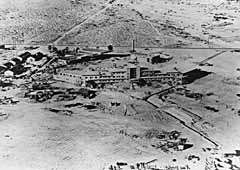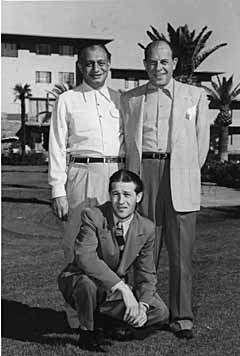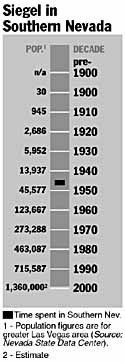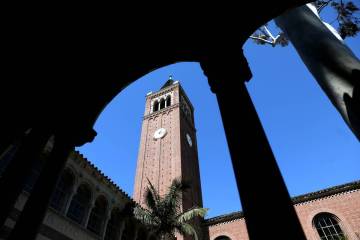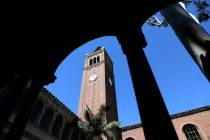Benjamin Siegel
For an incurable paranoid who had only a few moments left to live, Benjamin "Bugsy" Siegel was probably feeling pretty content.
It was June 20, 1947. Siegel had escaped the stifling Las Vegas heat for the cool shadows of the Moorish-style house at 810 Linden Drive in Beverly Hills. He'd just returned there from Ocean Park after a late dinner at Jack's-at-the-Beach. Settling onto the chintz sofa in the living room, a copy of the Los Angeles Times before him and his trusted pal, Al Smiley, a few feet away, the dapper Siegel was the picture of confidence.
He was probably as self-satisfied as a sociopath with a blood-soaked portfolio could be. After his Flamingo's disastrous grand opening on Dec. 26, 1946 -- the strains of Jimmy Durante's one-liners and Xavier Cugat's band fading amid the word that the casino had lost a fortune -- the shiny new Las Vegas resort was reopened March 27 and was finally turning a profit. That fact was almost certain to quiet the whispered rumors from New York and Miami Beach that his days as a Las Vegas casino mogul were numbered. Even his hell-raising girlfriend, the fiery Virginia Hill, was in Europe and out of shouting distance.
At age 41, Ben Siegel had carved out a notorious name for himself in the annals of organized crime and in Las Vegas history as well. Somehow, he had managed to walk between the raindrops and avoid conviction on a plethora of crimes ranging from bootlegging to murder. If he had not become a silver screen gangster, which his closest friends believed he secretly wanted to be, he had accomplished the next best thing: He had become a genuine gangster with movie star looks and had surrounded himself with the Hollywood glitterati.
In a few seconds, his name would become permanently etched in the American psyche. When people thought of Las Vegas, they would always think of Benny Siegel. Not because he had turned the Fabulous Flamingo into the snazziest carpet joint in Sin City, but because, at that moment, an assassin wielding a Army-issue carbine aimed at the back of Siegel's carefully coifed head and blew his brains and one of his pretty blue eyes all over the living room. Smiley was untouched. The shooter was never identified.
Siegel's .30-caliber send-off not only made headlines from L.A. to London, it linked the handsome psychopath forever with the fortunes of Las Vegas.
In a town with more than its share of wiseguy misfortune, what makes Siegel's demise so special? For that matter, what makes the infamous Bugsy worthy of a place in the pantheon of local historical figures?
Several things, really.
In an odd way, Siegel was better for business in death than in life. Had Siegel lived a long time, he might have ended up respectable or in the penitentiary. Had he died of a heart attack or the gout, he might have become a footnote in time.
Instead, he died violently and, in a sense, got to live forever.
Through the years, Siegel has been credited for everything from putting the glow in neon to inventing Las Vegas. The fact the Flamingo wasn't even his idea tells you something about how myths are made.
The Flamingo was the creation of Billy Wilkerson, a Hollywood nightclub owner and one of the founders of "The Hollywood Reporter." Wilkerson had plenty of big ideas and no shortage of friends in the underworld. The Flamingo was to be his crowning glory. By the mid-1940s, it was an unfinished dream deferred.
Enter Siegel.
Bugsy was not only a wealthy man in his own right and a big-time earner for his mob friends, but he had access to all the money the New York, Chicago and Miami Beach underworld could generate. Numerous published accounts of Siegel's status rank him as one of the most respected and feared names in the syndicate. He carried the sort of clout that was capable of persuading tightwads like Charlie "Lucky" Luciano and Meyer Lansky to invest in his desert dream. And they did.
Siegel and the boys bankrolled construction of the Flamingo with $1.5 million, but in the months following the end of World War II, materials were scarce. The job immediately ran over budget.
It didn't help that the four-floor Flamingo was built like a fortress, a testament to Siegel's paranoia. The thick concrete walls were reinforced with steel acquired from Naval ship yards. Siegel's top-floor suite was riddled with trap doors and escape hatches, one leading to a getaway car in his private garage. There were gun portals and hallways leading nowhere. The Flamingo was a physical manifestation of Bugsy Siegel's troubled brain.
But it also was filled with the sort of posh amenities never before seen in Las Vegas. Siegel not only poured big money into carpets and fixtures, he spared no expense on a pool, tennis courts and riding stables. Siegel's idea, his first Las Vegas attorney, the late Lou Wiener Jr. once said, was to create a real resort capable of not only attracting the Hollywood set, but also to give gamblers a variety of diversions from their inevitable losses at the tables. Siegel envisioned adding a championship golf course to the Flamingo, but his plans were interrupted.
Theft at the Flamingo construction site was legendary, a big part of the reason the hotel ultimately cost $6 million, an incredible figure for the times. "A lot of characters, I think, duped him," Wiener said. "They'd go through the front gates with materials and drive out the back." But at least one author suggests Siegel's own sticky fingers were responsible. Says Richard Hammer in his well-researched "Playboy's Illustrated History of Organized Crime:"
"Siegel was not only a flop as an impresario, but, Lansky said, he was a thief as well. Lansky had learned that Miss Hill was making frequent trips to Europe, depositing several hundred thousand dollars in cash in a numbered account in Switzerland; the cash had come from the Flamingo's building fund.
"Nobody, not even an old trusted comrade like Siegel, steals from his underworld friends and gets away with it. Siegel's execution was ordered, but first he would be given time to prove that his Nevada dream might actually come true."
It is possible, too, that Siegel's Hollywood profile became so high that he became an embarrassment to his associates. He was a silver-screen sycophant and groomed the acquaintance of major players such as Jack Warner, Cary Grant, Barbara Hutton, Jean Harlow and every hoodlum's favorite actor, George Raft. American gangsters learned how to walk by watching George Raft on the screen. They learned how to talk by listening to his snappy, wiseguy patter.
"He was a frustrated actor and secretly wanted a movie career, but he never quite had nerve enough to ask for a part in one of my pictures," Raft once said of his pal.
Las Vegas history buffs know Siegel as the man who developed the Flamingo, but few appreciate just how big a hoodlum he really was. Born in the Williamsburg section of Brooklyn in 1905, as a boy Siegel befriended Meyer Lansky. Together with a gang of teen-age toughs known as the Bug and Meyer Mob, they provided protection and efficiently performed a string of contract killings on behalf of the city's bootlegging fraternity. By the time World War II broke out, Siegel and Lansky had made the post-Prohibition transition from illegal whiskey running to illegal bookmaking, numbers running and gambling. Siegel lived at the Waldorf Astoria and traveled in a bullet-proof limousine with the requisite pair of torpedoes posing as bodyguards.
After coming West to oversee the Capone mob's successful takeover of the race wire business, Siegel's infatuation with Hollywood began to show -- and his profile began to rise dangerously high. At the same time he was muscling in on illegal gambling throughout Southern California, buying percentages of small Las Vegas casinos, clipping Tony Cornero's S.S. Rex gambling ship, and strong-arming his way into the Agua Caliente racetrack in Tijuana as well as a California dog track, Siegel was busy being seen in the company of Harlow and Raft and many other stars. Continental race wire sales to Las Vegas sports books alone generated $25,000 a month, according to "The Green Felt Jungle," and Siegel bought into the Golden Nugget and Frontier at a time his pal Lansky was picking up a piece of the El Cortez.
Siegel was one of the schemers behind opening a pipeline of narcotics trafficking from Mexico to the United States, and he raked a percentage of the profits from the largest prostitution ring in the West. If it moved in the netherworld of illegality, Benny Siegel got his pinch.
Siegel's temper was legendary. No one dared call him "Bugsy" to his face, and anyone with a smart aleck comment about his height or thinning hair was likely to get his teeth knocked down his throat. To some local observers, Siegel's maniacal chest-puffing set the pattern for several generations of big-shot casino moguls.
Las Vegan Herb McDonald, then a young assistant general manager at El Rancho Vegas, met Siegel through Billy Wilkerson. For a short time, McDonald knew Siegel only as a casino man.
"We played gin rummy, and I won 28 bucks," McDonald said in an article in Nevada magazine. "When I saw Ben Siegel again, he asked me when I was going to give him a chance to win some of his money back. I said, 'Any time you think you're good enough.' "
A short while later, McDonald learned Siegel's true background as a member of the board of Murder Inc.
"My knees buckled," McDonald said. "Had I known that, I would have lost it."
But Wiener knew Bugsy as an intense character who was not without a charitable streak. Siegel was a soft touch for the Damon Runyon Cancer Fund.
"When he got killed, you wouldn't believe how many employees broke down in tears," Wiener recalled. "He was very generous with the help and very well liked. He was good to people. He was good to me and my wife."
But others knew Siegel as a textbook paranoid.
"He used to go down to Los Angeles about every two weeks," said the Flamingo's first engineer, Don Garvin. "He'd have me change the lock on the door of his room almost every week. He and Virginia would sit out in the hall while I worked. He was a little leery. It got to where I would pretend to change it and hand him the same key."
But, in 1947, no amount of caution could prevent the boys from disciplining one of their own.
Wallace Turner put it bluntly in his break-through 1965 book, "Gamblers' Money:"
"Siegel was murdered reportedly to effect a change in management. There are those who firmly believe that this killing of the hoodlum Siegel irrevocably set the pattern for Las Vegas' development as a gambling center. The Mob was in, these observers hold, and the Mob has stayed ...
"In a sense he was the Christopher Columbus for the Mob; he went exploring and found the New World in the desert. But Siegel failed to adapt. It is possible that he became confused between the two ways of doing business and thought that because his name was on so many pieces of paper he really owned the Flamingo Hotel. He was wrong."
Today, the Flamingo Hilton is one of the larger casino resorts in the world. It has long since shed its association with Siegel's kind, but management saw fit to honor the Flamingo's founder with a bronze plaque and a small rose garden not far from the original site of the Flamingo's first pool.
What is Siegel's legacy?
"I think what it shows more than anything else is the public's fascination with gangster-type characters," Flamingo publicity director Terry Lindberg said. "(His death) turned a man who was basically not a historical figure into somebody who was a lot larger than life."
Others give Siegel more credit.
UNLV Public Administration Department Chairman William Thompson: "It's folklore, it's mythology ... His death let the world know we had casinos ...
"It was important that we turned the corner and quit being just a cowboy town and became a resort town. He was responsible for that."
It is a sentiment echoed by UNLV history professor Hal Rothman, author of "Devil's Bargain: Tourism in the Twentieth-Century American West."
"The most important thing about Siegel is he raised the ante here," said Rothman. "He had an idea, however bizarre, of what class was. As we become a resort destination, we actually owe him more and more."
Las Vegas historian Frank Wright: "His death was a great advertisement for the city of Las Vegas in a sense. It certainly brought attention to Las Vegas and created a sort of sense of illicit excitement about Las Vegas."
Ever a defender of the image of his old friend, Wiener credited Siegel with setting a standard others are still trying to match.
"He was one of the most progressive businessmen I've ever met," Wiener once said. "Had he been alive today, he probably would have had the first 3,000-room hotel in Las Vegas."
But Ben Siegel was not meant for such a tame fate. By spilling his blood, he lives forever in Las Vegas history.
Part I: The Early Years
Part II: Resort Rising
Part III: A City In Full




